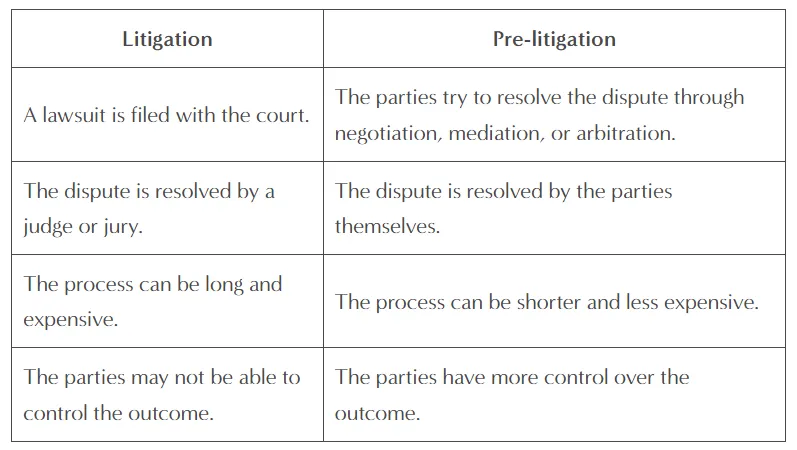
What Happens During Pre-Litigation?
The pre-litigation phase is the period of time before a lawsuit is filed. During this time, the parties involved try to resolve the dispute without going to court. This can be done through negotiation, mediation, or arbitration.
The Pre-Litigation Process
Are you navigating the complexities of a personal injury claim? Equip yourself with an understanding of the pre-litigation process. From initial notifications to robust investigations and critical settlement negotiations, delve into the meticulous steps that may circumvent a prolonged courtroom dispute. The pre-litigation process typically includes the following steps:
Notice
The injured party’s attorney will send a letter to the at-fault party’s insurance company, notifying them of the claim. This letter will also request the insurance company’s policy limits and coverage.
Investigation
The injured party’s attorney will investigate the accident and gather evidence to support the claim. This evidence may include medical records, photographs, witness statements, and police reports.
Demand Letter
Once the investigation is complete, the injured party’s attorney will send a demand letter to the insurance company. This letter will outline the injured party’s damages and demand a settlement.
Settlement Negotiations
The parties will then engage in settlement negotiations. These negotiations aim to reach an agreement that resolves the dispute without going to court.
If the parties cannot agree, the injured party may file a lawsuit. However, most cases are settled during the pre-litigation phase. Contact us at Activated Law for a consultation if you seek a qualified pre-litigation attorney.
The Benefits of Pre-Litigation
Here are some of the benefits of resolving a case during the pre-litigation phase:
• Cost savings: It is often much less expensive than going to court. This is because the parties can avoid the costs of filing a lawsuit, hiring lawyers, and going to trial.
• Time savings: Resolving a dispute through the court system can take months or even years.
• Privacy: It is usually confidential. This means that the dispute will not be made public, which can protect the parties’ privacy.
• Control: The parties have more control over the dispute outcome during this phase. This is because they can negotiate a settlement that meets their needs.
• Better outcome: In some cases, the parties can reach a better outcome during this phase than through the court system. This is because they are more likely to be willing to compromise and work together to find a fair solution for both sides.
If you are involved in a dispute, it is important to speak to an attorney as soon as possible. An attorney can help you understand your rights and options and guide you through pre-litigation.
Top Questions About Pre-litigation
Here are some frequently asked questions our firm receives regarding the matter…
What Happens First in the Litigation Process?
The first step in the litigation process is the filing of a complaint. The complaint is a document filed with the court that outlines the plaintiff’s claims against the defendant.
Once the complaint is filed, the defendant has a certain amount of time to file an answer. The answer is a document that responds to the allegations in the complaint. The defendant may also file counterclaims against the plaintiff.
After the answer is filed, the parties may engage in discovery. Discovery is the process of exchanging information and evidence. This can include things like interrogatories (written questions), requests for production of documents, and depositions (oral testimony).
The discovery process can be lengthy and expensive. However, it is important to gather all the relevant information to properly decide the case.
Once discovery is complete, the parties may file motions. Motions are requests to the court for rulings on various issues. For example, a party may file a motion to dismiss the case or a motion for summary judgment.
The case may go to trial if the parties cannot resolve their dispute through motions. The parties will present their evidence and arguments to the judge or jury at trial. The judge or jury will then decide the case.
What Does Moving Forward With Litigation Mean?
Moving forward with litigation means that you are taking the steps necessary to file a lawsuit. This can be a daunting process, but it is important to understand what is involved to make an informed decision about whether or not to proceed.
Here are some of the things that are involved in moving forward with litigation:
• Filing a complaint
• Serving the complaint
• Responding to the complaint
• Discovery
• Motions
• Trial
Moving forward with litigation can be a complex and time-consuming process. However, it is important to understand your rights and options to make an informed decision about whether or not to proceed. If you are considering moving forward with litigation, it is important to speak to an attorney as soon as possible. Activated Law can help sort out legal complexities on your behalf. Contact us for a consultation today!
What’s the Difference Between Litigation and Pre-litigation?
The main difference between litigation and pre-litigation is that litigation is the process of resolving a dispute through the court system. In contrast, pre-litigation is the process of trying to resolve a dispute without going to court.
Here is a table summarizing the key differences between litigation and pre-litigation:

Is Litigation the Same as Going to Trial?
No, litigation is not the same as going to trial. Litigation is the process of resolving a dispute through the court system while going to trial is the final step in the litigation process.
How Long Does the Pre-litigation Process Typically Take?
The pre-litigation process can take anywhere from a few weeks to several months or even longer. The specific length of time will vary depending on the case’s complexity and the parties’ willingness to cooperate.
Here are some factors that can affect the length of the pre-litigation process:
• The severity of the injuries
• The number of parties involved
• The willingness of the parties to cooperate
• The complexity of the case
What Are the Costs of Pre-litigation?
The costs of pre-litigation can vary depending on the specific case. However, some of the common costs associated with pre-litigation include:
• Attorney’s fees
• Expert witness fees
• Filing fees
Activated Law offers reasonable attorney’s fees. Contact us today to better estimate your total cost of pre-lit.
What Are the Risks of Not Settling During Pre-litigation?
There are several risks associated with not settling during pre-litigation. These include:
• The case may go to trial
• You may not get the full amount of compensation you deserve
• You may have to pay the other party’s legal fees
• The case may drag on for years
Conclusion
In summation, the pre-litigation process plays an indispensable role in the legal realm, offering a structured, time-efficient, and cost-effective avenue to dispute resolution prior to courtroom engagements. The stages, from notice to settlement negotiations, provide an opportunity for involved parties to find common ground. While the benefits of pre-litigation are evident, with advantages such as cost savings and increased privacy, the process demands a keen understanding and strategic approach.
Should you find yourself on the precipice of a legal dispute, it’s paramount to arm yourself with the expertise of seasoned professionals.
Secure your consultation with Activated Law, ensuring your rights and best interests remain at the forefront.
Photo by : NAMYNOT Inc.
